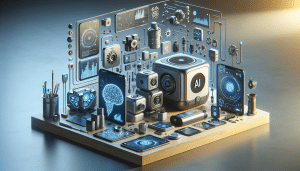AI in Everyday Life Surprising Ways You Benefit
Aiden Foster September 23, 2025
Artificial intelligence is shaping how people work, learn, and connect. Explore surprising ways AI touches daily routines, from health tips and smart homes to voice assistants and online recommendations. This in-depth guide reveals the practical benefits, considerations, and key concepts to help you understand AI’s growing role.
The Invisible AI: Subtle Impacts Around You
Artificial intelligence has moved beyond science fiction and into everyday life, though its presence often goes unnoticed. Most people engage with AI-powered solutions dozens of times each day. Online shopping experiences, for example, are enhanced by recommendation engines that study patterns and personal preferences to offer relevant product suggestions. The same underlying technology fuels personalized playlists on streaming platforms, suggesting new songs or movies based on previous choices. This constant, adaptive learning helps users find valuable content quickly—and often, without realizing an algorithm is working in the background.
Search engines use natural language processing and machine learning techniques to improve the quality of results. When a question is typed, AI systems scan massive databases, cross-check context, and deliver results tailored to perceived needs. This technology makes searching for health information, school research, or troubleshooting a household device both faster and more accurate. AI is even behind the grammar and spell-check tools embedded in email and messaging platforms, which help polish communication instantly.
AI’s invisible touch also appears in daily financial transactions. Fraud detection systems monitor banking and credit activities using real-time analytics, watching for unusual patterns or unauthorized use. These machine learning models continually adapt, becoming better at catching suspicious transactions while minimizing disruptions for legitimate users. Such proactive AI involvement provides greater security for online payments and peace of mind for users, all behind the scenes.
Smart Homes and Everyday Automation
Smart home technology, often powered by artificial intelligence, has made managing household routines almost effortless. Thermostats now learn daily schedules, adjusting temperature for comfort and energy savings. AI-enabled lighting systems adapt to user preferences and natural daylight cycles, enhancing mood and helping optimize sleep. Even robotic vacuum cleaners navigate rooms, map floor layouts, and avoid obstacles thanks to embedded AI, all while freeing up time for other activities.
Voice assistants have emerged as the centerpiece of many smart homes. By recognizing natural speech, these digital helpers answer questions, set reminders, and control other devices—all in real time. Behind the friendly voices are complex AI algorithms processing context and intent, learning from each interaction. Over time, these assistants become more attuned to unique preferences, transforming how household members interact with technology and each other.
Beyond convenience, smart home AI offers real benefits in accessibility and safety. For example, automated lighting can help those with mobility challenges, ensuring rooms are fully lit as needed. Smart doorbells with AI-based facial recognition and video analytics facilitate secure entry and monitor visitors even when no one is home. As technology evolves, new devices continue to integrate machine learning, anticipating needs and promoting more comfortable, connected living environments.
AI Meets Healthcare: Everyday Wellness Enhancements
Artificial intelligence is rapidly changing how people manage their health, often in subtle yet profound ways. Fitness apps now use adaptive algorithms to suggest personalized workout routines, adjusting intensity based on data collected from wearable devices. These AI health companions track activity, heart rate, and even sleep patterns, providing feedback and motivation to support healthy habits. Users benefit from custom advice that feels tailored to their lifestyle, even as the AI continues to learn from every interaction.
AI also supports wellness through early detection and prevention. Smartphone cameras running AI-powered apps can analyze skin anomalies and prompt users to seek further medical advice if needed. Some platforms even detect irregularities in voice or breathing, providing early warnings for potential respiratory issues. Machine learning helps sift through vast pools of health data, identifying trends that may not be obvious to doctors or patients. These technologies aren’t replacements for medical professionals, but they can guide timely action and improve long-term outcomes.
Medication management benefits from AI-enabled reminders and tracking. Smart pillboxes, for instance, alert users if a dose is missed and offer adherence suggestions based on routines or calendar events. These systems often integrate with health records, securely sharing essential information with providers when necessary. With an increasing focus on personalized medicine, artificial intelligence is expected to become an ally in smarter, more efficient healthcare for everyday life.
AI on the Move: Navigation and Travel Simplified
Navigating unfamiliar routes, avoiding traffic, and planning logistics have all become easier thanks to advancements in artificial intelligence. GPS and mapping apps rely on real-time analysis, powered by AI, to select efficient paths, assess road conditions, and provide up-to-date travel times. These systems aggregate enormous amounts of data from other drivers, weather sources, and public transit feeds, synthesizing useful recommendations for daily commutes or global adventures. The ripple effect: less time spent in traffic, safer journeys, and greater predictability.
Ride-hailing platforms lean heavily on machine learning. AI evaluates surges in demand, suggests meeting points, and matches riders to the closest available vehicles for quick service. Pricing can fluctuate based on demand—an outcome of AI analytics optimizing supply and efficiency. Beyond convenience, the same models support shared rides and eco-friendly planning, recommending carpool options to reduce environmental impact and lower costs for users comfortable with sharing a ride.
Travel booking also uses artificial intelligence to personalize options. AI curates destination suggestions, filters hotels, and highlights flights that align with past behaviors or stated preferences. This personalization helps even occasional travelers discover deals or experiences they may not have considered. The intelligence woven into travel platforms ensures trips are tailored, smoother, and suited to specific lifestyle needs.
Everyday Communication: Language, Translation, and Connection
Artificial intelligence has transformed communication, making it easier to connect across borders, cultures, and languages. Real-time translation tools, powered by AI, help break down language barriers in texts, video calls, and social media posts. Whether for work or leisure, instant translation can open up opportunities, support collaboration, and reduce misunderstandings. As these models evolve, accuracy and nuance improve, providing more reliable multilingual communication experiences.
AI-driven chatbots and virtual agents play a growing role in customer service, online retail, and technical support. These helpers can answer questions, process requests, and troubleshoot issues anytime, anywhere. Drawing from continuously updated knowledge bases, chatbots resolve basic queries quickly, freeing human agents for complex concerns. AI’s ability to ‘learn’ from past interactions helps create smoother, more satisfying engagements, improving user satisfaction and accessibility.
Even casual communication is shaped by artificial intelligence. Spell-checkers, predictive text, and smart email filters help users express ideas clearly and filter out spam or unwanted content. Many messaging platforms offer suggestions to complete sentences, maintain tone, or catch potential errors, allowing for faster and more precise correspondence. These everyday conveniences might go unnoticed, but they add efficiency and polish to digital exchanges.
AI Tools for Productivity and Learning
In both home and work life, AI-driven productivity tools streamline projects, scheduling, and information management. Calendar apps automatically suggest meeting times that fit everyone’s schedule, while task managers categorize priorities and alert users to deadlines. Intelligent document analyzers scan and summarize reports, freeing time for creative or strategic work. These tools adapt to personal workflows and improve with consistent use, making life a bit easier each day.
Online learning platforms have seen dramatic improvements by incorporating AI. Recommendation engines suggest relevant courses, quizzes adapt to skill levels, and automated grading provides instant feedback. Students benefit from personalized study plans that adjust dynamically, promoting engagement and better retention. Lifelong learners enjoy broader access to information tailored precisely to their goals—whether it’s mastering a new language or brushing up on technical skills.
Remote work and collaboration receive a boost from AI-enhanced video conferencing and team tools. Background noise suppression, real-time transcription, and note-generation are now commonplace features, powered by advanced algorithms. These capabilities foster inclusion, ensuring voices are heard clearly and important details are never missed. As reliance on digital workspaces grows, artificial intelligence helps bridge gaps and maintain both productivity and connectivity.
References
1. National Institute of Standards and Technology. (n.d.). Artificial Intelligence. Retrieved from https://www.nist.gov/artificial-intelligence
2. Pew Research Center. (2022). How Americans View Artificial Intelligence. Retrieved from https://www.pewresearch.org/internet/2022/06/21/how-americans-view-artificial-intelligence/
3. U.S. Food and Drug Administration. (n.d.). Artificial Intelligence and Machine Learning in Software as a Medical Device. Retrieved from https://www.fda.gov/medical-devices/software-medical-device-samd/artificial-intelligence-and-machine-learning-software-medical-device
4. Stanford University Human-Centered Artificial Intelligence. (n.d.). Artificial Intelligence Index Report. Retrieved from https://hai.stanford.edu/research/ai-index-report
5. World Health Organization. (2021). Ethics and Governance of Artificial Intelligence for Health. Retrieved from https://www.who.int/publications/i/item/9789240029200
6. IBM. (n.d.). What is Artificial Intelligence (AI)? Retrieved from https://www.ibm.com/topics/artificial-intelligence








